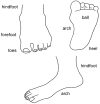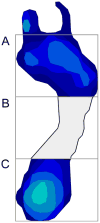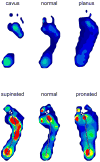Association of planus foot posture and pronated foot function with foot pain: the Framingham foot study
- PMID: 23861176
- PMCID: PMC4089968
- DOI: 10.1002/acr.22079
Association of planus foot posture and pronated foot function with foot pain: the Framingham foot study
Abstract
Objective: To examine the associations of foot posture and foot function to foot pain.
Methods: Data were collected on 3,378 members of the Framingham Study cohort who completed foot examinations in 2002-2008. Foot pain (generalized and at 6 locations) was based on the response to the following question: "On most days, do you have pain, aching or stiffness in either foot?" Foot posture was categorized as normal, planus, or cavus using static pressure measurements of the arch index. Foot function was categorized as normal, pronated, or supinated using the center of pressure excursion index from dynamic pressure measurements. Sex-specific multivariate logistic regression models were used to examine the effect of foot posture and function on generalized and location-specific foot pain, adjusting for age and weight.
Results: Planus foot posture was significantly associated with an increased likelihood of arch pain in men (odds ratio [OR] 1.38, 95% confidence interval [95% CI] 1.01-1.90), while cavus foot posture was protective against ball of foot pain (OR 0.74, 95% CI 0.55-1.00) and arch pain (OR 0.64, 95% CI 0.48-0.85) in women. Pronated foot function was significantly associated with an increased likelihood of generalized foot pain (OR 1.28, 95% CI 1.04-1.56) and heel pain (OR 1.54, 95% CI 1.04-2.27) in men, while supinated foot function was protective against hindfoot pain in women (OR 0.74, 95% CI 0.55-1.00).
Conclusion: Planus foot posture and pronated foot function are associated with foot symptoms. Interventions that modify abnormal foot posture and function may therefore have a role in the prevention and treatment of foot pain.
Copyright © 2013 by the American College of Rheumatology.
Figures




References
-
- Thomas MJ, Roddy E, Zhang W, Menz HB, Hannan MT, Peat GM. The population prevalence of foot and ankle pain in middle and old age: A systematic review. Pain. 2011;152:2870–2880. - PubMed
-
- Benvenuti F, Ferrucci L, Guralnik JM, Gangemi S, Baroni A. Foot pain and disability in older persons: an epidemiologic survey. J Am Geriatr Soc. 1995;43:479–484. - PubMed
MeSH terms
Grants and funding
LinkOut - more resources
Full Text Sources
Other Literature Sources
Medical

